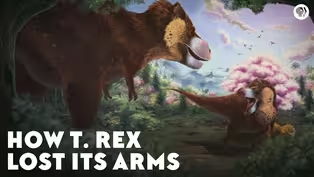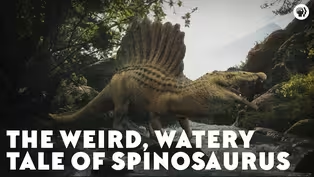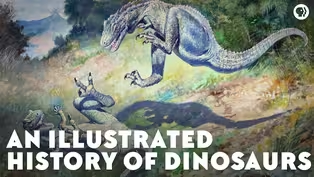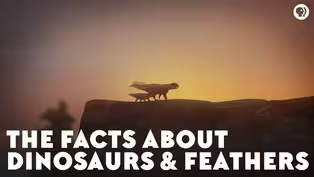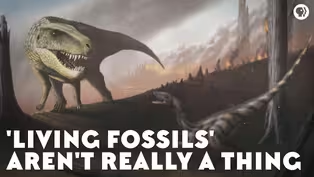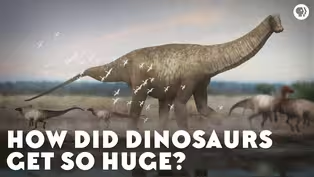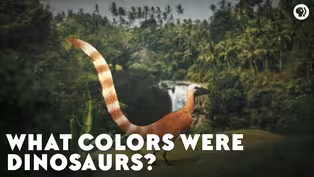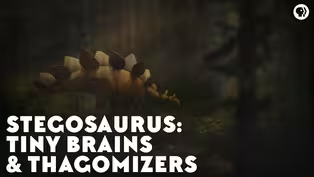
Inside the Dinosaur Library
Season 1 Episode 36 | 7m 19sVideo has Closed Captions
We talk to Amy Atwater, Collections Manager at the Museum of the Rockies.
We're back in Bozeman, Montana this week talking to Amy Atwater, Collections Manager at the Museum of the Rockies. MOR has among the largest collections of North American dinosaurs in the United States. We talk to Amy about her job and the collection she manages.
Problems playing video? | Closed Captioning Feedback
Problems playing video? | Closed Captioning Feedback

Inside the Dinosaur Library
Season 1 Episode 36 | 7m 19sVideo has Closed Captions
We're back in Bozeman, Montana this week talking to Amy Atwater, Collections Manager at the Museum of the Rockies. MOR has among the largest collections of North American dinosaurs in the United States. We talk to Amy about her job and the collection she manages.
Problems playing video? | Closed Captioning Feedback
How to Watch Eons
Eons is available to stream on pbs.org and the free PBS App, available on iPhone, Apple TV, Android TV, Android smartphones, Amazon Fire TV, Amazon Fire Tablet, Roku, Samsung Smart TV, and Vizio.
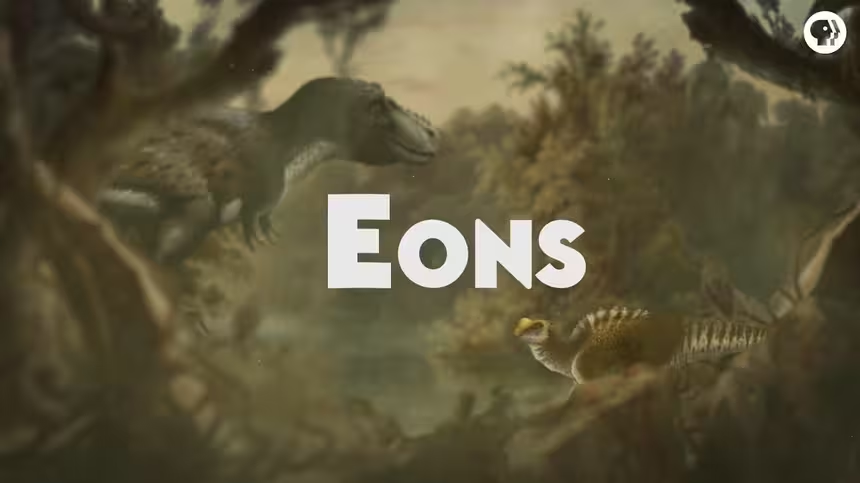
Welcome to Eons!
Join hosts Michelle Barboza-Ramirez, Kallie Moore, and Blake de Pastino as they take you on a journey through the history of life on Earth. From the dawn of life in the Archaean Eon through the Mesozoic Era — the so-called “Age of Dinosaurs” -- right up to the end of the most recent Ice Age.Providing Support for PBS.org
Learn Moreabout PBS online sponsorshipMore from This Collection
Eons videos all about Dinosaurs
Video has Closed Captions
Tyrannosaurus rex had tiny arms. How did this happen, and why did it keep them? (6m 54s)
The Weird, Watery Tale of Spinosaurus
Video has Closed Captions
In 1912, a fossil collector discovered the world’s only known semi-aquatic dinosaur. (7m 28s)
An Illustrated History of Dinosaurs
Video has Closed Captions
Our image of dinosaurs has been constantly changing since naturalists started studying the (12m 20s)
The Facts About Dinosaurs & Feathers
Video has Closed Captions
Dinosaurs have been found with some sort of fluff or even full-on plumage. (10m 1s)
Living Fossils' Aren't Really a Thing
Video has Closed Captions
Even the most ancient-looking organisms show us that evolution is always at work. (5m 5s)
How Did Dinosaurs Get So Huge?
Video has Closed Captions
Creatures as tall as a five-story buildings shook the Earth. (5m 42s)
Video has Closed Captions
We know a lot about dinosaurs but there’s one question that has plagued paleontologists.. (5m 2s)
Stegosaurs: Tiny Brains & Thagomizers
Video has Closed Captions
If you take it as a given that extinct dinosaurs were all weird and wonderful, then you go (4m 49s)
Providing Support for PBS.org
Learn Moreabout PBS online sponsorshipDuring our first field trip to Bozeman, Montana we met with Paleohistology Lab manager Dr. Ellen-Thérèse Lamm who showed us the fascinating world inside of fossilized bones.
But we also visited Amy Atwater, who is a Collections Manager, like me.
She's in charge of the Vertebrate Paleontology Collection, located in the basement of the Museum.
With a backdrop of Edmontosaurus and Tyrannosaurus rex bones, she describes her job and the collection she manages.
Hey everybody it's Kallie here again I'm at the Museum of the Rockies in the Vert Paleo collection talking to the new Collections Manager Amy Atwater.
Thank you so much for having us here today in this amazing collection.
What is your paleontological background like what's your specialty?
So I most recently completed my master's degree at the University of Texas at Austin where I focused on Eocene mammals and specifically Eocene primates so it's something that not a lot of folks know that around forty five million years ago actually like 56 to about 43 million years ago we had little prosimian lemur-like tarsier-like primates jumping around hopping around North America, the United States.
We mostly focus on their teeth and they're extremely small my biggest sample had teeth that were about two millimeters by one millimeter so in length by width so.
Lots of microscope work, huh?
Everything under a microscope absolutely on everything So this is kind of interesting....you manage this massive dinosaur collection and you study teeny tiny little mammals.
I always had place for the big megafauna in my heart and it's been exciting to have an opportunity to protect and take care of all sizes of fossils here at thr Museum the Rockies The Museum of the Rockies has among the largest collections of North American dinosaurs in the United States.
It also holds the largest collection of T. Rex and Triceratops fossils in the world.
Managing a large collection of massive million year old bones is a surprisingly delicate task.
So I'm a collections manager at the University of Montana just like three hours to the west of here but can you describe to our audience what is a collections manager what do you do?
What's your role?
I do a lot of things and try to take care of all of the fossils.
I usually deal with fossils after they have been removed from the field taken out in the field jacket and usually after they've been prepared by our preparators and then they make their way to me and my office and it's my job to take the fossil, make sure we have all the necessary information, make sure that it's labeled properly.
John has often referred to collection managing is kind of like being a librarian which I'm sure you can relate to.
Fossil Librarian!
Exactly and that's true we take care of these objects and then make sure that as they're in their final long-term storage, that they're still in a safe place that they have a nice cradle to protect them, that they have some foam around them if they need that, that we have all the right information on them and make sure that they're taken care of and also available to visiting researchers.
And you mentioned the cradles and we have some lovely cradles behind us here can you elaborate a little bit of what the purpose of one of these cradles is?
Sure of course.
Fossils have been in the ground for millions of years as you know and when we bring them to the surface, this is not the most stable environment for them.
So we want to make sure that they have everything to be as protected as possible to minimize any amount of damage that could take place and it really just helps maintain the long-term safety of these finite resources.
We don't want to screw it up we don't want one of these things --yeah you can't just like go out and collect another one--well sometimes maybe but-- - -nothing that is of that individual right - -yeah ---exactly so we talked about that a lot.
Some folks will say just go get another t-rex and well they're not all the same and I wish I could just go find another that'd be great--that'd be great We'd all be out of a job is that easy just go out find me another one!
Exactly so every fossil that comes in is unique it's finite it's the only one of its specific type.
It's already fragile.
It is millions of years old so that is a lot to ask of anything and we want to do everything we can to make sure that we can research them for hundreds and hundreds and hundreds of years.
Now you mentioned prep and prepping a fossil what do you do when you prep a fossil?
When a fossil is discovered in the field it is rarely in a pristine ready to go on display state.
You know we don't find a perfectly articulated t-rex standing there waiting to be found that just isn't how geology works so when we bring them out of the field, they're usually still within a lot of sediment that they were found with and that's part of their jacket and so the preparators job is to get the jacket off from the field and work away all of that sediment and stabilizing the bone at the exact same time.
It's just about getting them to being there they're true bone instead of being still partially excavated if you will.
And then while you're doing that you frequently will use a variety of glues and putties to get everything to stick together and to hold together correctly so that it will be stable and so that it could go on exhibit someday as well.
So there are a lot of amazing things in this collection I can imagine, what is like the most special or unique or rare thing that's here at the MOR Something that really put Museum of the Rockies on the map was eggs and dinosaurs in embryos and nestlings and this idea of some dinosaurs caring for their young.
I personally think that for me the most exciting and unique thing that I've learned about and been really excited about is a specific t-rex specimen MOR 1125 which we call "B-Rex"--It was found by Bob Harmon one of our preparators so it's called B-Rex in his honor.
And Dr. Mary Schweitzer has done a lot of work with this B-Rex individual and she looks at soft tissues in bone they were able to identify what the soft tissue in the femur was and it's medullary tissue and that is something we only see today in female birds that are preparing to lay eggs.
It's a source of calcium.
So because of that by using the comparative method we can conclusively say that B-Rex was female and she is the first t-rex to be conclusively shown to be of one sex or the other.
One of my other favorites has been this incredibly beautiful Borophaginae skull and a Borophaginae is a bone-crushing dog so they have these incredible teeth that were just--- they are ridiculous--- just insane and it's the most beautiful skull and jaw I've ever ever had the joy of looking at.
So this was super cool Amy thank you so much for having us here today and talking about your amazing job is there anything you want to end with or sign off?
I just want to encourage everybody out there to go visit the Museum of the Rockies Heck yeah, Great thanks so much!
Thank you


- Science and Nature

A documentary series capturing the resilient work of female land stewards across the United States.












Support for PBS provided by:

